1) Two towers: Asinelli and Garisenda
They are the landmark of the city of Bologna. The
taller one – Asinelli – was raised to the current 97,20 meters when it became
Municipal property at the end of the 13th century. Originally, it had to reach
a height of about 60 meters: from that point upward the walls actually become
thinner showing the builder’s intention to raise the tower’s height without
overburdening it with a weight that could have made it unstable. In fact, the
tower’s original (defensive) purpose, was the defense so, it wasn’t necessary
it was particulary high, while it served the need of the Municipality like a
beacon tower to communicate with the countryside. The Garisenda tower instead, should have been
60 meters high but it was lowered to 47,50 meters mid
14th century for fear it would collapse, even following the earthquake of 1351;
Sure enough, the tower’s tilt is believed to have started immediately, caused
by the sinking of land (the overhang measures 3,2 meters). Both the Asinelli
tower and the Garisenda tower date back to the 11 th century, in which nobles
families of Bologna competed with each
other, building by prestige and fortification increasingly tall towers. Bologna
came to count nearly 200 towers!
2) Palazzo d’Accursio o Comunale
The
oldest part of the building dates back to 1293 and was owned by the old noble
house of the noble Francesco d'Accursio. In 1444 the clock was placed in the
tower of the Accursio. Inside the Palazzo d'Accursio, of enchanting beauty, we
can admire the Red Hall, so named because of the red tapestries, illuminated by
elegant chandeliers in Bohemian crystal deriving from a nineteenth-century
renewal, and which, today, is used for the celebration of weddings.
5) Piazza Maggiore
It is the
main square of the city of Bologna and is located right in the city center just
in front of Palazzo d'Accursio, the seat, until a few years ago, of the
Municipality and of all the municipal offices. Its construction began in the
early 1200s during the construction of the Palazzo del Podestà.
3) Piazza e Fontana del Nettuno
Piazza
and Fontana del Nettuno: The famous bronze statue of the God Neptune, placed on
the fountain of the homonymous square, represents the God Neptune in the act of
appeasing the waves. The statue, as well as the dolphins and sirens are the
work of the sculptor Giambologna (1563-1566).
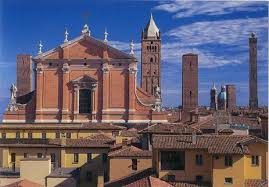
6) Cattedrale Metropolitana di San Pietro
The
façade is in Baroque style and has on its sides two imposing sculptures of San
Pietro and San Paolo. The church is enriched with paintings by Prospero Fontana
(1579), Ludovico Carracci (1618), Marcantonio Franceschini (1728) and Donato
Creti (1740). Of particular interest is a crucifix between the Madonna and San
Giovanni Evangelista made of wood from the 12th century. The 70-meter
bell-tower was raised at the beginning of the 13th century around a
pre-existing cylindrical tower of the 10th century. The bell tower is the
second tallest building after the Torre degli Asinelli and offers one of the
most beautiful views of the city of Bologna.
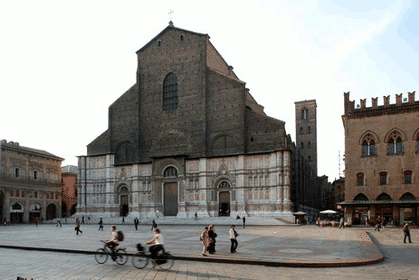
4) Basilica di San Petronio
Basilica
of San Petronio: To build the church dedicated to the patron of the city (which
was a bishop in the fifth century) an entire neighborhood was demolished. The
works lasted from 1390 to 1658 approximately. The imposing dimensions (32 m in
length and 60 in width, with a vault height of 45 m) make it one of the largest
churches in Italy. It can hold about 28,000 faithful.
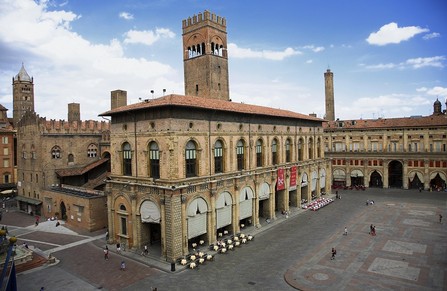
7) Palazzo del Podestà
Built between 1201 and 1203, it overlooked Piazza Maggiore where the market was held, and was equipped with a large hall for government activities. The palace was given a bell tower in 1212, which forty years later would have been replaced by the current tower of the Arengo. With the construction of the current Palazzo Comunale in the first half of the fifteenth century the Palazzo del Podestà was used as an archive. It was begun a restructuring never completed, during 1484 by Giovanni II Bentivoglio, belonging to one of the noble families that governed the city over the centuries.
8) Under Bologna there is a small great Venice
Bologna is crossed a dense network of rivers and canals, although hidden which, over the centuries, contributed to the economic development of the city through the processing of silk that needed water to run the mills . Between the 12th and 16th centuries an urban system of canals developed, which allowed water to be used for domestic purposes, for sewers, for ditches along the walls of the town and for grain and silk mills. The canal system was based on three waterways: the Aposa stream which is the only waterway that runs through the town from south to north, the river Reno and the Savena stream that, coming from outside the city, brought waters within the walls of the town through 2 canals that came one from the west and the other from the east. At the end of the 1800s the canals were grafted to make way for the streets that today take the emblematic name of Via Del Porto, Via Delle Moline, Via Riva di Reno and Via Val D'Aposa. The canals are still visible in some small windows located between the buildings such as in Via Piella, Via Oberdan. For making the excursion to the Aposa torrent you can lead from the central Piazza San Martino, descending a steep flight of steps.
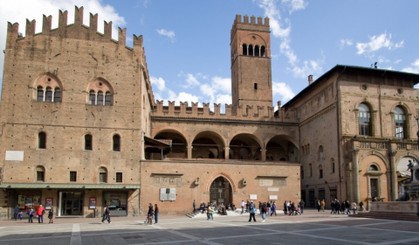
12) Palazzo Re Enzo
It was built between 1244 and 1246. It owes its name to King Enzo, son of the emperor Frederick II of Swabia who, in the thirteenth century, was imprisoned and never freed by the Bolognese after being captured in the battle of Fossalta in 1249, despite a lot of money offered by his father. The body of King Enzo is buried in the Church of San Domenico.
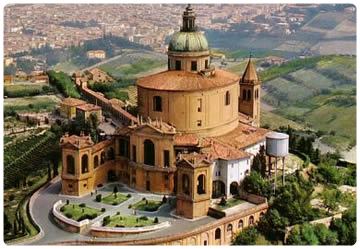
9) Sanctuary of the Madonna di San Luca
The church standing today was built by Carlo Francesco Dotti between 1723 and 1757 to replace a previous 15th century church (1400), while the two outside tribunes were completed by his son Giovanni Giacomo in 1774. The portico (front porch) of almost 4 kilometers connects the Sanctuary to the city of Bologna and sees the unfolding of the procession that every year since 1433 bears the icon of the Madonna with Child of Byzantine origin, during the week of the Ascension, from the Sanctuary to Bologna and back to the Sanctuary. The start of the climb to the Sanctuary is signaled along via Saragozza, from the arc of the Meloncello, designed by Carlo Francesco Dotti.
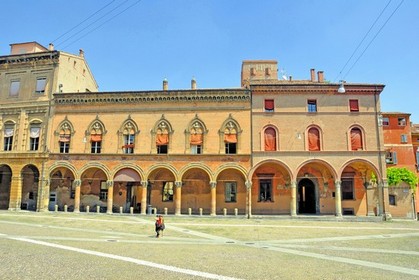
13) Palazzo dell’ Archiginnasio
It was wanted by Pius IV to give permanent seat to the University and to unify the schools of Law and the Arts, the palace was erected on the design of Antonio Morandi (1562-1563). It is decorated with coats of arms, sculptures or paintings that recall, rectors, priors and students who attended it between 1500 and 1700. The Archiginnasio hosted the University until 1803. Since 1838 it is the seat of the prestigious Municipal Library, still present with a heritage of over 800,000 works. In the anatomical theater inside the Archiginnasio Palace there is a sculpture by the anatomist Mondino de 'Liuzzi who was the first to practice autopsies for educational purposes in Bologna, starting around 1315.
10) I Porticoes of Bologna
Bologna, with its 35 Km in the historical center and the other 15 km that are outside the walls, is known as the city of Porticoes. The Bologna of the Roman period before and of the Lombard period then, with its narrow streets and the scarce spaces for the growing urban development due to the increase of the population, pushed to the search of alternative solutions to obtain new spaces, among which there was to extend the load-bearing beams of the floors of the first floors of the houses towards the road, to build small wooden buildings, which protruded outwards. This involved the birth of the current city porticatoes which showed its usefulness both as a workplace for craftsmen and traders and as a pedestrian street sheltered from the elements.
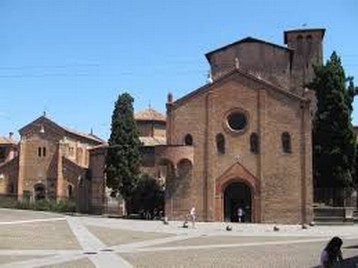
14) Basilica di Santo Stefano (The seven Churches)
Tradition wants it founded by the bishop Petronius in the fifth century AD, dedicated to St. Stephen martyr, in the following centuries it saw the construction of other places of worship wanted by the Benedictine friars. The complex is in fact known as the "Seven Churches" even if, to date, the remaining places of worship are 4. The church of the Crucifix is of Lombard origin (VIII century). The church of Calvary, with the reproduction of the holy sepulcher, once housed the relics of San Petronio, now kept in the basilica bearing the same name. The third church of San Vitale and Agricola preserves the sarcophagi of the two Bolognese Saints Martyrs. In the fourth place of worship, in the church of the Trinity you can admire a wooden sculpture of the XIII-XIV century of Simone dei Crocifissi, which represents the adoration of the Three Kings and which is considered the oldest crib existing in the world.
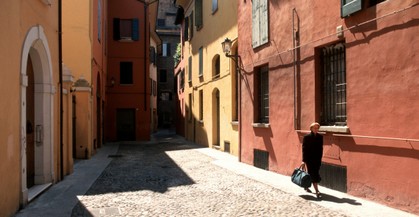
11) The ancient Jewish ghetto
With its secluded and quiet lanes, the ghetto is ideal for a relaxing walk. You can start from Via de 'Giudei, the entrance to the ghetto from Piazza di Porta Ravegnana where, the wide open space of the square, makes room for the two towers. These streets of the Jewish ghetto were once a frenetic crossroads, where merchants, bankers and sellers of rags practiced their professions. Via dell 'Inferno was the main artery in which a network of small roads converged: Via De' Giudei, Via Canonica, San Giovanni alley, Vicolo Mandria, Via del Carro and Via Valdonica. At number 16 in Via Dell 'Inferno, the building overlooks the only synagogue in the ghetto. A plaque on the outer wall recalls the terrible events suffered by the Jewish community in Bologna in the fifteenth and sixteenth centuries (in 1569 the Jews were expelled from Bologna) and during the criminal racial persecution of 1938-45 by the nazi-fascists.









